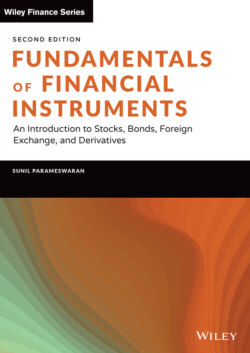Читать книгу Fundamentals of Financial Instruments - Sunil K. Parameswaran - Страница 56
На сайте Литреса книга снята с продажи.
EXAMPLE 1.5
ОглавлениеTake the case of a company based in India that is being traded at INR 60.00 per share, at a time when the exchange rate is INR 75 per US dollar. If an ADR were set to be equal to one Indian share, it will trade for approximately 80 cents in the United States. In order to ensure that the ADRs trade at a more respectable price, one ADR may be made equivalent to 10 domestic shares, thereby ensuring that it trades at approximately $8.00.
On the other hand a share may be trading at a very high price in its home country. For instance, if a share is trading at INR 37,500 in India, it will trade at approximately $500 in the United States, assuming a 1:1 issue ratio and an exchange rate of INR 75 per dollar. In such circumstances one ADR may be set equal to 0.05 Indian shares, thereby ensuring that it trades at approximately $25 in the United States.
The ADR market is growing from the standpoints of both supply as well as demand. Foreign companies are being increasingly attracted to the US market for it is the largest in the world and is arguably the most efficient. Unlike other nations, the United States presents fewer barriers to entry. Compared to other countries the United States has more High-Net-Worth Individuals (HNWIs) who are not only better endowed financially, but are more aware of the benefits of international diversification and willing to take the attendant risks.
Although an American investor can always acquire a share that is traded on a foreign stock exchange, it is a lot simpler in practice to invest in an ADR. There is no need to locate a foreign broker or be conversant with the systems and practices of a foreign stock exchange and its related institutions. Besides, acquiring a foreign security will expose the investor to exchange rate risk. In most countries reporting standards are not as stringent as those prevalent in the United States. Consequently, companies abroad are able to get away with less disclosure, which may not be adequate for an American. A practical difficulty from the standpoint of trading foreign shares is that such transactions can be undertaken only when the overseas market is open, and the timings of these trading venues usually do not overlap with American market hours.
One of the advantages of ADRs is that an ADR may offer greater liquidity in the United States than the underlying shares do in their domestic market. Moreover, certain US pension funds and investment managers have a strong preference for ADRs because they are legally required to invest in ADRs while investing in non-US securities. Many institutional investors prefer investing in securities that are listed for trading in the US market rather than investing directly in foreign equity markets.
In order to list its shares on the exchange of a developed country, the issuing company must meet the securities market regulations of the foreign country as well as those of the stock exchange on which the shares are to be listed. This very often requires the company to comply with stringent disclosure norms. For instance, in order to list on the New York Stock Exchange (NYSE), it is necessary to comply with US GAAP (generally accepted accounting principles). For companies based in developing countries, such compliance has ensured more transparency in their operations, leading to the benefit of not just global investors, but also the domestic shareholders. However, after issues like the ENRON collapse, it is arguable as to whether the disclosure norms in the United States are as commendable and effective as once believed. Besides, many other countries have considerably beefed up their security-related regulations to a large extent, as a response to financial scams and scandals.
Foreign listing provides a multinational corporation (MNC) with indirect advertising for its product brands in the foreign market. It also raises the profile of the company in international capital markets, making it easier for it to raise finances in the future, and provides greater mileage for its international marketing efforts. Take the case of an Indian company which is seeking to raise a bank loan in London. It will have greater credibility in the eyes of the international lending community if it were to be listed on an exchange in the developed world. Besides, when a firm's equity is held by shareholders across the globe, the risk of a hostile takeover of the firm may reduce somewhat.
There could be instances where foreign investors put a higher premium on the issue than do domestic investors. This could be the case, for instance, if the foreign market were to have greater experience in dealing with a particular industry. As Geddes points out, there was a flood of issues by international mining companies on the Toronto Stock Exchange in the mid-1990s.3 This is because it was felt that Canadian investors had greater experience in evaluating shares of such firms.
At times a firm may go in for a global issue because it perceives its domestic market to be too small for an issue of the size it is contemplating. In Europe, for example, this fact has compelled Scandinavian and Eastern European firms to access markets across their borders.
There are two broad categories of ADR programs: sponsored and unsponsored. In the case of a sponsored program, the exercise is initiated by the foreign firm whose shares are sought to be traded in the United States. In the case of an unsponsored issue, the process will typically be initiated by an investment bank in the United States that has acquired shares in a foreign market.
